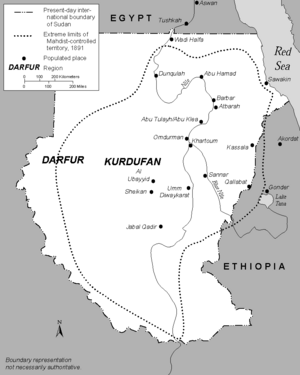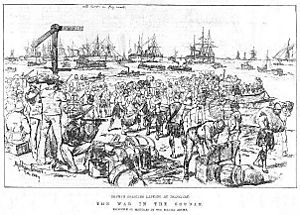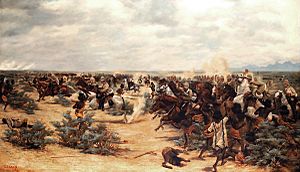First and Second Battles of El Teb facts for kids
Quick facts for kids First and Second Battles of El Teb |
|||||||
|---|---|---|---|---|---|---|---|
| Part of the Mahdist War | |||||||
 Mahdist Sudan |
|||||||
|
|||||||
| Belligerents | |||||||
* |
|||||||
| Commanders and leaders | |||||||
| Osman Digna | Valentine Baker Sir Gerald Graham |
||||||
| Strength | |||||||
|
4 February: 10,000 warriors Unknown artillery |
4 February: 4,500 British and Indian infantry and cavalry 22 artillery pieces 6 machine guns |
||||||
| Casualties and losses | |||||||
|
4 February: 2,000 killed Unknown wounded |
4 February: 30 killed 142 wounded |
||||||
The First and Second Battles of El Teb were important fights during the Mahdist War in Sudan. These battles happened on February 4 and February 29, 1884. In the first battle, a Sudanese force led by Osman Digna defeated an Egyptian army. Later, a British force under Sir Gerald Graham arrived. They fought Osman Digna's forces and won with few losses.
Contents
Why the Battles Happened
Britain got involved in Sudan because they supported the Khedive of Egypt. The Khedive was like a ruler, and Britain helped him after a revolt in 1882. This support was to protect the Suez Canal, a very important shipping route. It also aimed to stop the slave trade in Sudan.
However, the British government didn't want to get too involved in Sudan. Sudan was controlled by Egypt at the time. But a religious leader named Muhammad Ahmad, known as the Mahdi, started an uprising. He declared a Jihad, which is a holy war, against the Egyptian troops. The Mahdi's forces were very successful. Many Egyptian towns found themselves surrounded. Because of this, the British told the Egyptians to pull their troops out of Sudan.
The First Battle: February 4, 1884
The port city of Suakin, on the Red Sea, could still get supplies by ship. But two towns further inland, Tokar and Sinkat, were completely cut off. In February 1884, about 3,000 soldiers were sent from Suez to Suakin. Their mission was to help the trapped soldiers in Tokar and Sinkat.
General Valentine Baker, also known as Baker Pasha, led this force. He had other European officers with him. But the mission faced problems from the start. Most of the soldiers were Egyptian police officers. They had joined the police force only to work in Egypt. When they heard they were going to Sudan, many ran away. The rest became unhappy and refused to obey orders.
On February 3, Baker moved his troops by ship from Suakin to Trinkitat. This was a coastal town near Tokar. He set up a camp on the beach. The next day, they started marching. The Egyptian soldiers were not used to marching in order. They moved forward in a confused crowd.
At a place called El Teb, on the road to Tokar, they were attacked. A Mahdist force of 1,000 warriors charged them. Even though Baker's troops had more soldiers and better weapons, they panicked. They fired only one shot and then ran away. The Mahdists chased them and killed many soldiers. All the European officers who tried to fight were killed. Baker couldn't get his men to fight. He retreated to the camp with only a few survivors. Out of 3,500 soldiers, only about 700 made it back.
After this defeat, Baker tried to defend Suakin. But the Egyptian soldiers no longer trusted the British officers. They refused to follow orders. This loss sealed the fate of the trapped towns. The Sinkat soldiers tried to reach Suakin on foot. They were all killed. The Tokar soldiers surrendered without a fight.
The Second Battle: February 29, 1884
Baker's defeat made many people in Britain angry. Some, like Lord Wolseley, demanded that British troops be sent. The British government agreed, even though they didn't want to. Several army units returning from India were sent to Suakin instead.
On February 21, a force led by Sir Gerald Graham left for El Teb. They went through Trinkitat. This force had 4,500 British and Indian soldiers. They also had 22 cannons and 6 machine guns. On February 29, they got close to the main Mahdist position. This was on a hill near El Teb. The Mahdists had dug trenches and rifle pits. They also had cannons, including some captured from the Tokar soldiers. Some Tokar soldiers had even joined the Mahdists.
The British soldiers formed a large square shape. This formation helped them protect themselves from all sides. They moved around the Mahdist trenches to get behind them. They fired many rifles and cannons. After a short fight with cannons, the Mahdist guns stopped firing. Then the British advanced.
The Mahdists hid in their trenches to avoid the British bullets and cannon fire. Then, they would rush out in small groups of 20 or 30 warriors. This was different from the large attacks the British expected. Another trick they used was to pretend to be dead on the ground. When British cavalry (soldiers on horseback) rode past, the Mahdists would suddenly get up. They would then attack the riders as they returned slowly.
At the top of the hill, the Mahdists had made a village into a strong fort. Here, they fought hard. The British infantry had to use their bayonets (knives attached to rifles) to clear the trenches. After this, the fighting slowly stopped.
During the battle, Captain Arthur Wilson showed great bravery. He joined a naval gun crew after their officer was badly wounded. When the Mahdists charged the gun crew, Wilson bravely fought them alone. He protected his men until other British soldiers arrived to help. For his brave actions, he was given the Victoria Cross, a very high military award.
Graham's force then moved on to Tokar. They didn't face any more resistance. After the battle, most of the equipment lost by Baker's force was found. The British had only a few soldiers killed or wounded. The Mahdists suffered heavy losses, with 2,000 of their warriors killed.
After the Battles
When Sir Gerald Graham returned to Britain, he was thanked by the government. He was also promoted to Lieutenant General for his excellent service.
Many soldiers showed great courage during the battle. Quartermaster Sergeant William Thomas Marshall was given the Victoria Cross by Queen Victoria. He bravely rescued a wounded officer during a cavalry charge. Sergeant Henry Phipps was also recognized for staying with his troops after being wounded twice. He even saved another soldier's life.
The First and Second Battles of El Teb were part of a growing conflict in Sudan. This conflict eventually led to the Anglo-Egyptian conquest of Sudan in 1898. In that later campaign, a large force, including Winston Churchill, helped Britain take control of Sudan.
Images for kids




